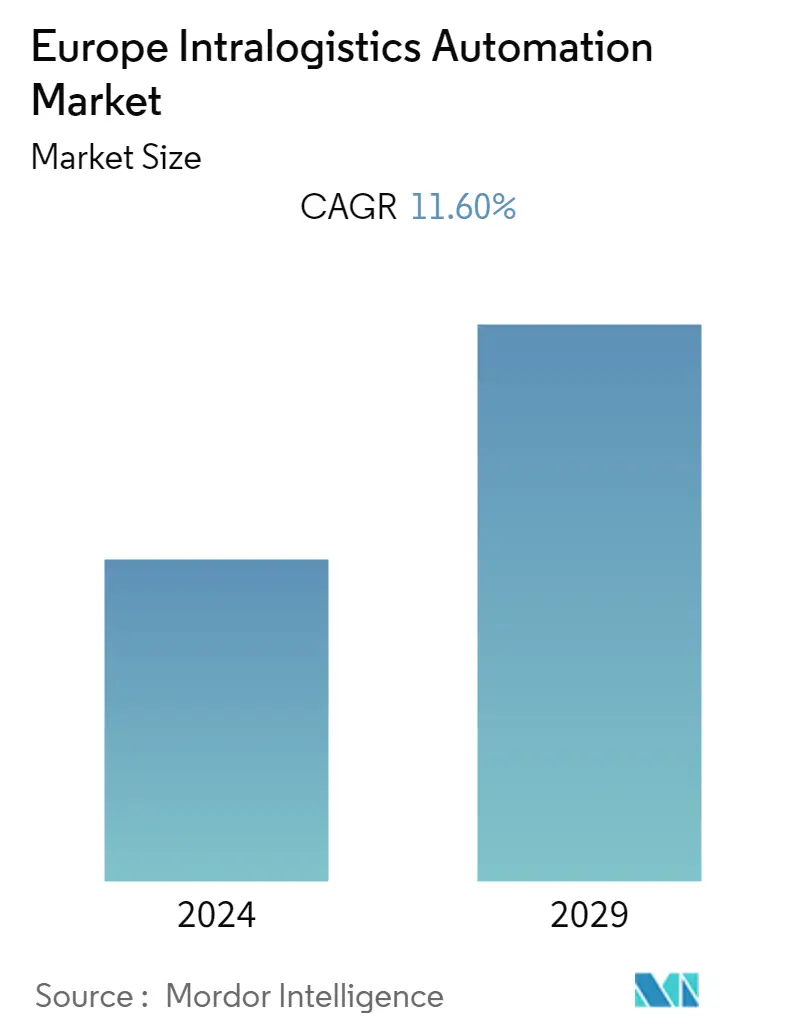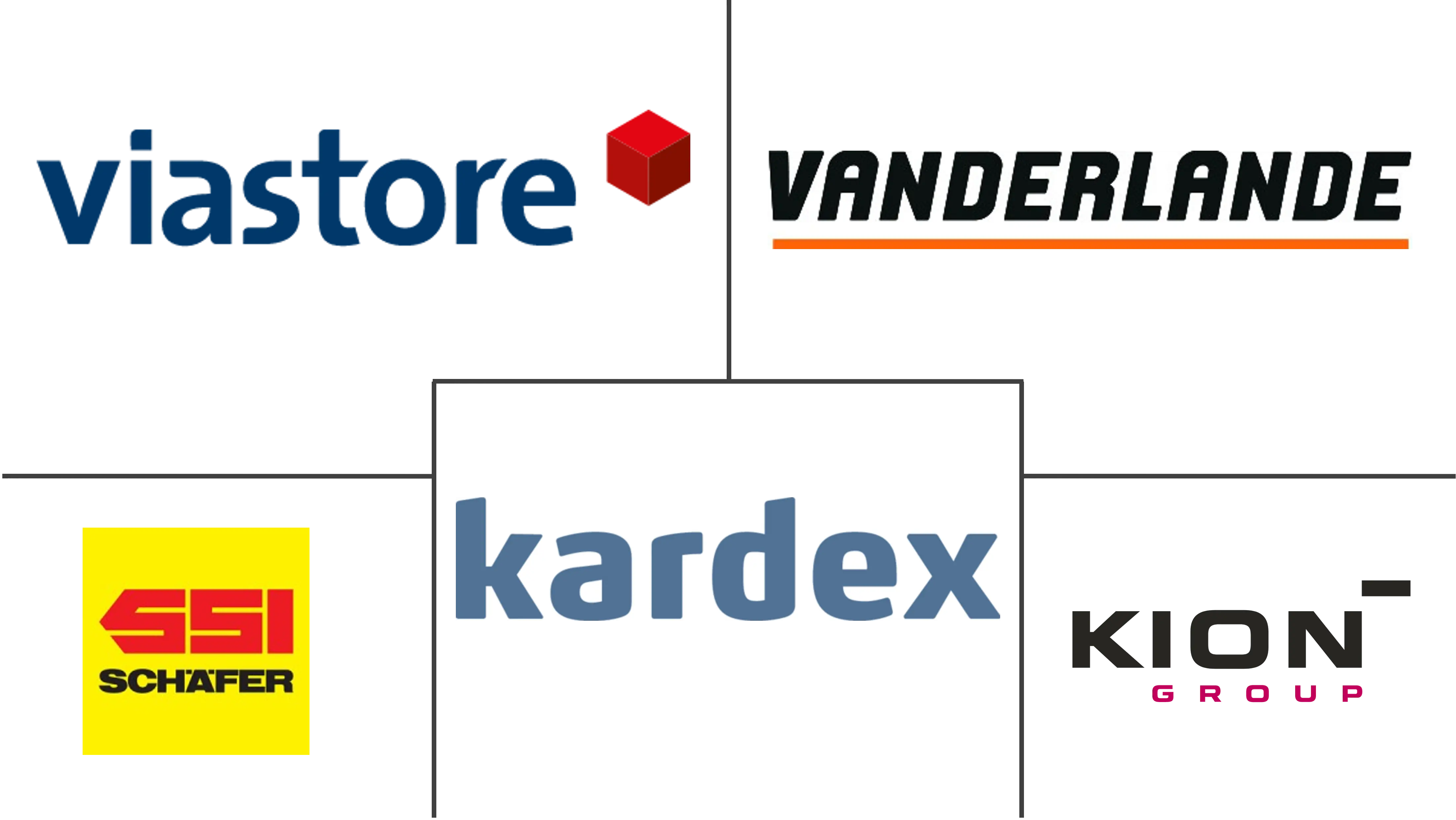Market Size of Europe Intralogistics Automation Industry

| Study Period | 2019 - 2029 |
| Base Year For Estimation | 2023 |
| Forecast Data Period | 2024 - 2029 |
| Historical Data Period | 2019 - 2022 |
| CAGR | 11.60 % |
| Market Concentration | Low |
Major Players
*Disclaimer: Major Players sorted in no particular order |
Europe Intralogistics Automation Market Analysis
The European intralogistics automation market is expected to grow at a high CAGR of 11.6% over the forecast period. The market is growing due to the universal demand for increased productivity and efficiency across industries. Furthermore, the advent of Industry 4.0 has compelled industries to go digital with their supply chains.
- Due to increased investments in the Industry 4.0 revolution, Europe has become the most prominent industrial automation adopter. According to the CBI Ministry of Foreign Affairs, Europe accounts for more than one-third of global Industry 4.0 investments. Western and Northern Europe are its primary markets, particularly Germany, the originator of the term and a market leader.
- Intralogistics is in high demand across Europe. Automation is expected to increase significantly with the adoption of cutting-edge technologies such as IIOT (Industrial Internet of Things) and 5G by manufacturing industries in order to boost productivity, thereby improving the harmonious use of technology, labor, and equipment. Furthermore, smart supply chain technology adoption is on the rise. Companies are heavily investing in warehouse management software in order to create a savvy supply chain. This software ensures on-time delivery, giving businesses a competitive advantage.
- This has made logistics companies understand the specific demand effects of their business, develop a short-term demand synchronization strategy, and plan for possible channel shifts. Also, the companies shifted to using automation for better logistics services.
- Moreover, many industries are changing their priorities in order to survive the insidiously rapid digital age and contribute significantly to the entire world. Progressive globalization has become essential for companies looking to grow. Market internationalization and in-progress integration, as well as the emerging impact on society, are used to categorize globalization. World trade and economic growth have been boosted by increasing exports and imports through the use of intralogistics and the inclusion of emerging nations.
- The booming e-commerce sector has the potential to support the development of intralogistics solutions. Global e-commerce has experienced significant growth as a result of rising customer connectivity driving demand. Due to the low prices of its products, this industry is flourishing. Significant e-commerce trends that are influencing the intralogistics industry include zero-defect goals, seasonal peaks; shorter delivery times; bidirectional commodity flows; flexible delivery slots; and a wider range of parcel sizes and weights. The intralogistics market will expand alongside e-commerce as it reaches new heights.
- However, installing intralogistics in any industry is a difficult task. Both the process's complexity and its associated costs are quite high. The cost of designing, planning, and installing intralogistics is included in the setup cost. Robots, AS/RS, automated guided vehicles, and sorting systems are more expensive than anticipated.
- The COVID-19 pandemic spread significantly across the globe, including Europe, thereby severely impacting the logistics and supply chain operations, particularly in countries such as Germany, France, Italy, and the United Kingdom. Retail, industrial goods, and consumer goods are among the major industries in Europe that have been severely impacted by the COVID-19 outbreak. Supply chain disruptions impacted businesses in both the long and short term.
Europe Intralogistics Automation Industry Segmentation
Intralogistics integrates all internal business processes that take place while handling products. All industries are significantly impacted by the movement of goods during receipt, storage, and transfer, which is the subject of this phrase. Regardless of the type of product handled, a secure storage system enables up to 85% space optimization, 60% more stock capacity, a zero-error picking rate because manual search is no longer required, and a reduction in energy consumption of up to 60%.
Moreover, the European Intralogistics automation market is segmented by type (hardware, software), end-user industry (airport, post & parcel, general manufacturing, automotive, food and beverage, retail, warehousing & distribution), and country. The market also includes the assessment of the impact of COVID-19 on the market.
| Type | |||||||||
| |||||||||
| Software |
| End-user Industry | |
| Airport | |
| Post & Parcel | |
| General Manufacturing | |
| Automotive | |
| Food and Beverage | |
| Retail, Warehousing & Distribution | |
| Other End-user Industries |
| Country | |
| United Kingdom | |
| Germany | |
| France | |
| Italy | |
| Rest of Europe |
Europe Intralogistics Automation Market Size Summary
The European intralogistics automation market is experiencing significant growth, driven by the increasing demand for enhanced productivity and efficiency across various industries. The push towards digitalization, fueled by the Industry 4.0 revolution, has positioned Europe as a leading adopter of industrial automation technologies. This trend is particularly evident in Western and Northern Europe, with Germany at the forefront, leveraging advanced technologies like the Industrial Internet of Things (IIoT) and 5G to optimize supply chains. The market is further bolstered by the booming e-commerce sector, which demands sophisticated intralogistics solutions to meet zero-defect goals, shorter delivery times, and flexible delivery options. Despite the challenges posed by high setup costs and complex installation processes, the adoption of automation technologies such as autonomous mobile robots (AMRs) and automated guided vehicles (AGVs) is on the rise, enhancing inventory management and operational efficiency.
The market landscape is characterized by intense competition and fragmentation, with companies focusing on innovation through product launches, strategic partnerships, and acquisitions. Key players are investing in sustainable technologies and optimization systems to maintain a competitive edge. Germany's robust manufacturing sector, particularly in automotive and pharmaceutical industries, drives the demand for automated material handling solutions. The country's high robot density and significant investments in industrial robots underscore its leadership in the region. Additionally, collaborations between companies like Caja Robotics and Fives, as well as strategic partnerships involving Hai Robotics, highlight the ongoing efforts to integrate advanced automation solutions in warehouse logistics. These developments, alongside the strategic moves by companies such as Siemens Logistics and Duravant LLC, are shaping the future of the intralogistics automation market in Europe.
Europe Intralogistics Automation Market Size - Table of Contents
-
1. MARKET INSIGHTS
-
1.1 Market Overview
-
1.2 Industry Attractiveness - Porter's Five Forces Analysis
-
1.2.1 Threat of New Entrants
-
1.2.2 Bargaining Power of Buyers
-
1.2.3 Bargaining Power of Suppliers
-
1.2.4 Threat of Substitute Products
-
1.2.5 Intensity of Competitive Rivalry
-
-
1.3 Impact of COVID-19 on the Market
-
-
2. MARKET SEGMENTATION
-
2.1 Type
-
2.1.1 Hardware
-
2.1.1.1 Mobile Robots (AGV, AMR)
-
2.1.1.2 Automated Storage and Retrieval Systems (AS/RS)
-
2.1.1.3 Automated Sorting Systems
-
2.1.1.4 De-palletizing/Palletizing Systems
-
2.1.1.5 Conveyor Systems
-
2.1.1.6 Automatic Identification and Data Collection (AIDC)
-
2.1.1.7 Order Picking Systems
-
-
2.1.2 Software
-
-
2.2 End-user Industry
-
2.2.1 Airport
-
2.2.2 Post & Parcel
-
2.2.3 General Manufacturing
-
2.2.4 Automotive
-
2.2.5 Food and Beverage
-
2.2.6 Retail, Warehousing & Distribution
-
2.2.7 Other End-user Industries
-
-
2.3 Country
-
2.3.1 United Kingdom
-
2.3.2 Germany
-
2.3.3 France
-
2.3.4 Italy
-
2.3.5 Rest of Europe
-
-
Europe Intralogistics Automation Market Size FAQs
What is the current Europe Intralogistics Automation Market size?
The Europe Intralogistics Automation Market is projected to register a CAGR of 11.60% during the forecast period (2024-2029)
Who are the key players in Europe Intralogistics Automation Market?
Viastore Systems GmbH, Vanderlande Industries BV, Kardex AG, Schaefer Holding International Gmbh and KION Group AG are the major companies operating in the Europe Intralogistics Automation Market.

